-
Out of stock
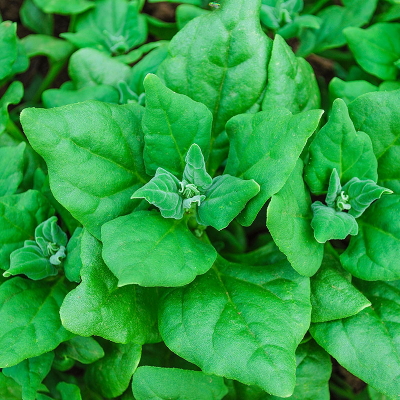 Tetragonia Expansa- New Zealand Spinach is a very old heirloom introduced into England in 1772 by Sir Joseph Banks. It was reportedly discovered during the South Seas expedition of Captain Cook. The crew ate it to combat survey on their voyage. This spinach-like plant thrives in hot dry weather. Small broad pointed leaves develop on large, spreading plants and tender leafy shoots. Due to oxalates in the leaves, blanch the leaves in hot water for at least a minute followed by cold water rinsing. Discard the water leaves should not be eaten raw. New Zealand Spinach tolerates salty soils. New Zealand Spinach is a tender perennial and killed by frost. In our gardens in Rocky View, AB we have found the New Zealand Spinach to self-seed though not prolifically. In spring we simply lift the young "volunteer" plants when they have two sets of true leaves and plant where desired.
Tetragonia Expansa- New Zealand Spinach is a very old heirloom introduced into England in 1772 by Sir Joseph Banks. It was reportedly discovered during the South Seas expedition of Captain Cook. The crew ate it to combat survey on their voyage. This spinach-like plant thrives in hot dry weather. Small broad pointed leaves develop on large, spreading plants and tender leafy shoots. Due to oxalates in the leaves, blanch the leaves in hot water for at least a minute followed by cold water rinsing. Discard the water leaves should not be eaten raw. New Zealand Spinach tolerates salty soils. New Zealand Spinach is a tender perennial and killed by frost. In our gardens in Rocky View, AB we have found the New Zealand Spinach to self-seed though not prolifically. In spring we simply lift the young "volunteer" plants when they have two sets of true leaves and plant where desired. -
Out of stock
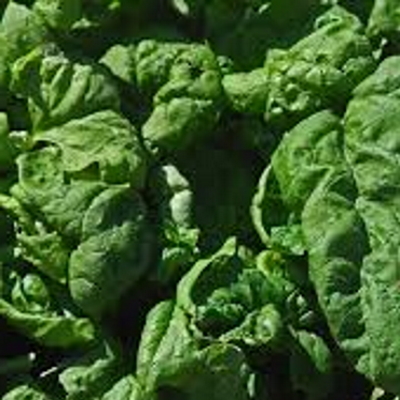 An open-pollinated French heirloom, dating back to the 1800s, Viroflay spinach is known for its huge leaves that can grow up to 20 cm long. Try using young leaves for fresh eating and let them grow for harvesting and freezing. The leaves maintain a fine flavour regardless of whether you harvest them at full size or as baby spinach. Grows quickly and does especially well in the fall/winter garden. Sow in August for fall crop, cover with frost cloth and have the earliest spring spinach.
An open-pollinated French heirloom, dating back to the 1800s, Viroflay spinach is known for its huge leaves that can grow up to 20 cm long. Try using young leaves for fresh eating and let them grow for harvesting and freezing. The leaves maintain a fine flavour regardless of whether you harvest them at full size or as baby spinach. Grows quickly and does especially well in the fall/winter garden. Sow in August for fall crop, cover with frost cloth and have the earliest spring spinach. -
Out of stock
 A stunningly colored and robust, red celery variety that will become a favourite for its continual harvests of gorgeous, succulent stalks. A range of red shades from burgundy to brilliant red and even blanched to golden pink, all with green foliage. From the breeding talents of Frank Morton who crossed the heirloom, Giant Red with Ventura. Giant red celery is one of Europe's most treasured heirlooms, not only for its striking colour, but its true celery flavour that is prized in soups. Redventure combines the best of both of these celeries. Harvest a stalk at a time for salads. Fully mature plants produce a nice semi-blanched golden-pink heart.
A stunningly colored and robust, red celery variety that will become a favourite for its continual harvests of gorgeous, succulent stalks. A range of red shades from burgundy to brilliant red and even blanched to golden pink, all with green foliage. From the breeding talents of Frank Morton who crossed the heirloom, Giant Red with Ventura. Giant red celery is one of Europe's most treasured heirlooms, not only for its striking colour, but its true celery flavour that is prized in soups. Redventure combines the best of both of these celeries. Harvest a stalk at a time for salads. Fully mature plants produce a nice semi-blanched golden-pink heart. -
Out of stock
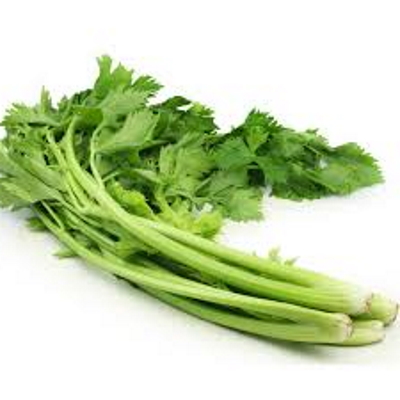 Celery in 45 days may seem unbelievable but this great Chinese celery will provide you with a great crop of fresh organic celery that is superb for salads, fresh eating, and especially flavourful in soups and stews, and of course in stir-fries. Thinner heads and stalks than regular celery mean you can have more plants in less space. It retains flavour when frozen. If you have had trouble growing regular celery in the past, or if you don't want to wait the three months or more it takes to mature, try Chinese Celery seeds and you'll become a lifetime convert. More flavour and no full of regular celery. Use leaves and stalks, grow in winter under polytunnels. During summer months cut stems and let them come again. A first-time celery grower's choice.
Celery in 45 days may seem unbelievable but this great Chinese celery will provide you with a great crop of fresh organic celery that is superb for salads, fresh eating, and especially flavourful in soups and stews, and of course in stir-fries. Thinner heads and stalks than regular celery mean you can have more plants in less space. It retains flavour when frozen. If you have had trouble growing regular celery in the past, or if you don't want to wait the three months or more it takes to mature, try Chinese Celery seeds and you'll become a lifetime convert. More flavour and no full of regular celery. Use leaves and stalks, grow in winter under polytunnels. During summer months cut stems and let them come again. A first-time celery grower's choice. -
Out of stock
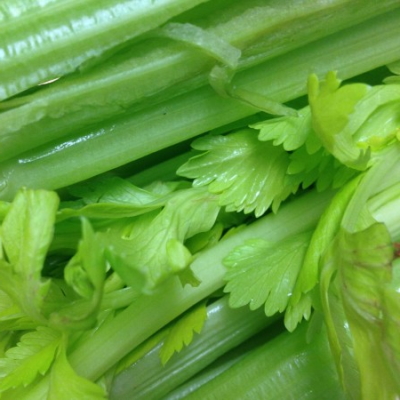 Tall Utah is a disease-resistant variety with large, full hearts with round, smooth ribs. The dark green, stringless stalks are tender, crisp, and tasty. There is no doubt that celery is a demanding vegetable to grow. At the same time, it is a rewarding vegetable to grow for gardeners with skill, determination, and a space to start the seeds indoors. Tall Utah has an early maturity and is resistant to bolting under summer stress. Vigorous plants produce nicely flavoured, crisp stalks. Plants reach a mature height of 45 cm. Stalks can be picked young and enjoyed.
Tall Utah is a disease-resistant variety with large, full hearts with round, smooth ribs. The dark green, stringless stalks are tender, crisp, and tasty. There is no doubt that celery is a demanding vegetable to grow. At the same time, it is a rewarding vegetable to grow for gardeners with skill, determination, and a space to start the seeds indoors. Tall Utah has an early maturity and is resistant to bolting under summer stress. Vigorous plants produce nicely flavoured, crisp stalks. Plants reach a mature height of 45 cm. Stalks can be picked young and enjoyed. -
Out of stock
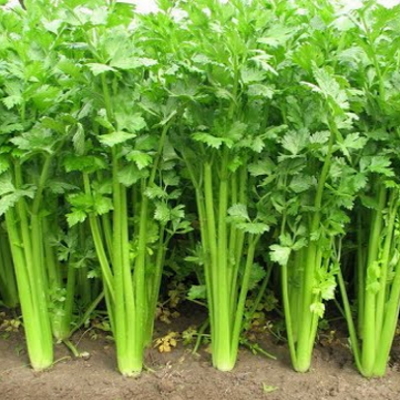 Command Celery is popular for fresh market celery growers and has dark green foliage with reduced suckering. Bunches are compact and blocky with good stalk length. Good tolerance to bolting and fusarium yellows. Celery can be challenging to grow, however, when directions are followed carefully, home gardeners can expect amazing results. Freshly picked organically grown celery is a must for juicers and celery lovers. Excellent crop for cool weather and high altitude gardens. Learn the techniques that celery growers know and you'll love growing and eating fresh celery.
Command Celery is popular for fresh market celery growers and has dark green foliage with reduced suckering. Bunches are compact and blocky with good stalk length. Good tolerance to bolting and fusarium yellows. Celery can be challenging to grow, however, when directions are followed carefully, home gardeners can expect amazing results. Freshly picked organically grown celery is a must for juicers and celery lovers. Excellent crop for cool weather and high altitude gardens. Learn the techniques that celery growers know and you'll love growing and eating fresh celery. -
Out of stock
 The Autumn King carrot is one of the more popular varieties to grow. Its split-resistant skin turns to a deep dark orange/red color as it matures. One of the largest carrots! Grows 25-30 cm long. Easy to grow in sandy soil. A favorite of many home growers. Carrots are sun-loving plants that also like the cold. Just keep them consistently watered and they'll be happy. If heavy frost is forecast, either harvest for winter storage or processing, or mulch with a thick layer of straw.
The Autumn King carrot is one of the more popular varieties to grow. Its split-resistant skin turns to a deep dark orange/red color as it matures. One of the largest carrots! Grows 25-30 cm long. Easy to grow in sandy soil. A favorite of many home growers. Carrots are sun-loving plants that also like the cold. Just keep them consistently watered and they'll be happy. If heavy frost is forecast, either harvest for winter storage or processing, or mulch with a thick layer of straw. -
Out of stock
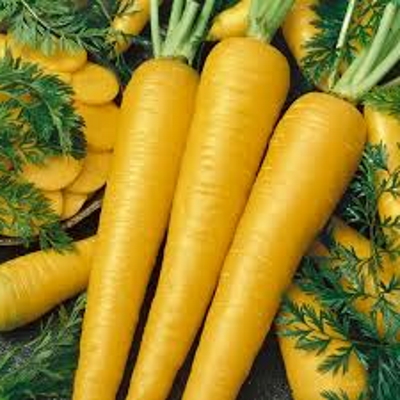 Yellowstone has large, tapered, pale yellow imperator roots that look sensational on the plate! This novel carrot has a wonderful flavour either raw or cooked and makes a great soup carrot. A decidedly sweet root with a canary yellow colour and appreciated just as much raw as when cooked. Long smooth roots hold their colour throughout the cooking process. Packed with vitamins C, E, and K, plus folate and the antioxidant lutein. Yellowstone stores well in the ground for winter harvests and is lovely as a roasted vegetable with parsnips and other winter harvest root crops. Best carrot to sow in August for fall and winter harvests. Roots are sweeter after a few hard touches of frost. Yellowstone grow to 25 cm but their flavour is superior when harvested small!
Yellowstone has large, tapered, pale yellow imperator roots that look sensational on the plate! This novel carrot has a wonderful flavour either raw or cooked and makes a great soup carrot. A decidedly sweet root with a canary yellow colour and appreciated just as much raw as when cooked. Long smooth roots hold their colour throughout the cooking process. Packed with vitamins C, E, and K, plus folate and the antioxidant lutein. Yellowstone stores well in the ground for winter harvests and is lovely as a roasted vegetable with parsnips and other winter harvest root crops. Best carrot to sow in August for fall and winter harvests. Roots are sweeter after a few hard touches of frost. Yellowstone grow to 25 cm but their flavour is superior when harvested small! -
Out of stock
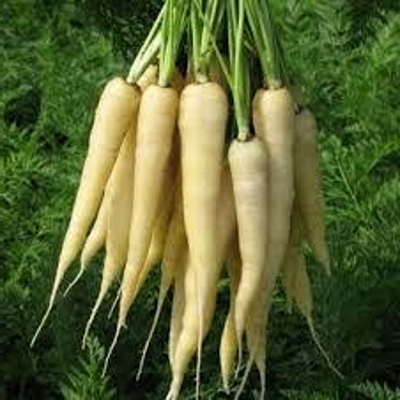 Vigorous variety producing creamy-white roots. Tender, almost coreless. Sweet flavour. White carrots have been sold in European markets for 300 years or more. Mild in flavor, this true white variety is quite a delicacy. Excellent long storage ability. 55 days to maturity. Lunar White Carrots average 20 cm in length.
Vigorous variety producing creamy-white roots. Tender, almost coreless. Sweet flavour. White carrots have been sold in European markets for 300 years or more. Mild in flavor, this true white variety is quite a delicacy. Excellent long storage ability. 55 days to maturity. Lunar White Carrots average 20 cm in length. -
Out of stock
 Heirloom Carrots are some of the premier baby carrots available. Bright orange, these heirloom carrots grow about 9 cm long. Each sweet carrot is crisp with a tender core. Their small size lets them grow well in containers, as well as out in the garden. Little fingers are a Nantes type of carrot. Bred in France, they develop their characteristic orange colour earlier than other varieties, these carrots can be harvested early at 8-9cm. Don't let them stay in the ground beyond around 68 days from sprouting or they begin to lose their unique gourmet flavour and texture.
Heirloom Carrots are some of the premier baby carrots available. Bright orange, these heirloom carrots grow about 9 cm long. Each sweet carrot is crisp with a tender core. Their small size lets them grow well in containers, as well as out in the garden. Little fingers are a Nantes type of carrot. Bred in France, they develop their characteristic orange colour earlier than other varieties, these carrots can be harvested early at 8-9cm. Don't let them stay in the ground beyond around 68 days from sprouting or they begin to lose their unique gourmet flavour and texture. -
Out of stock
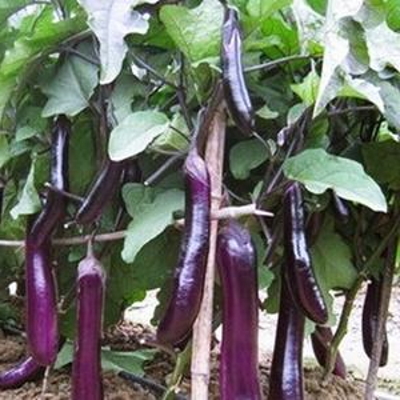 Ping Tung is the name of the town in Taiwan where it originated, making it an excellent variety for Asian cuisine. The fruits are light purple, from 30-45 cm long, and only 3 cm in diameter. Hardy, disease-resistant plants bear up to 20 sweet and tender fruit per plant. Stake the bushy plants for the straightest fruits. Eggplants thrive in containers, provided the soil is kept moist especially during the hottest days when they are fruiting. The plants work well in the open field and raised beds but benefit from full sun and wind protection. Eggplants grow best in heat.
Ping Tung is the name of the town in Taiwan where it originated, making it an excellent variety for Asian cuisine. The fruits are light purple, from 30-45 cm long, and only 3 cm in diameter. Hardy, disease-resistant plants bear up to 20 sweet and tender fruit per plant. Stake the bushy plants for the straightest fruits. Eggplants thrive in containers, provided the soil is kept moist especially during the hottest days when they are fruiting. The plants work well in the open field and raised beds but benefit from full sun and wind protection. Eggplants grow best in heat. -
Out of stock
 The Diamond Eggplant is definitely a good one! Each plant produces several pounds of slender fruit. Their flesh is firm and not bitter. This variety comes from Ukraine and is a super short season variety. The most reliable for Canadian gardens. This is a great all-around heirloom eggplant variety, adaptable to any home organic garden. Diamond Eggplants Mature in about 70 days and are an open-pollinated eggplant variety.
The Diamond Eggplant is definitely a good one! Each plant produces several pounds of slender fruit. Their flesh is firm and not bitter. This variety comes from Ukraine and is a super short season variety. The most reliable for Canadian gardens. This is a great all-around heirloom eggplant variety, adaptable to any home organic garden. Diamond Eggplants Mature in about 70 days and are an open-pollinated eggplant variety. -
Out of stock
 Developed by the late Professor Elwyn Meader in New Hampshire in 1964. Productive upright 50-75 cm plants. Oval fruits are 12.5 in diameter with pale green skin and mild white flesh. Non-acid flavor, no need to peel. Extra-early and productive. 62-70 days from transplant. If there’s one thing about this brinjal variety that has everyone talking, it’s the taste. And yes, you eat it green! If you leave the fruits on the plant for too long, they will turn yellow, but will also lose that fabulous flavour that is its claim to fame. To add to your pleasure, the plants are resistant to mildew.
Developed by the late Professor Elwyn Meader in New Hampshire in 1964. Productive upright 50-75 cm plants. Oval fruits are 12.5 in diameter with pale green skin and mild white flesh. Non-acid flavor, no need to peel. Extra-early and productive. 62-70 days from transplant. If there’s one thing about this brinjal variety that has everyone talking, it’s the taste. And yes, you eat it green! If you leave the fruits on the plant for too long, they will turn yellow, but will also lose that fabulous flavour that is its claim to fame. To add to your pleasure, the plants are resistant to mildew. -
Out of stock
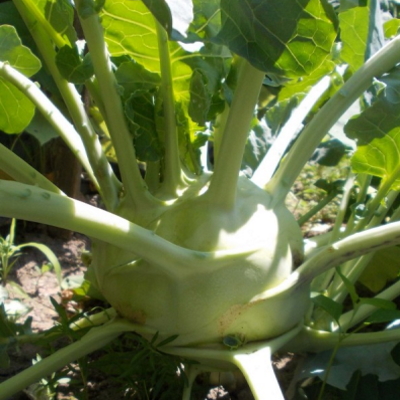 Superschmeltz reaches mammoth proportions all the while remaining tender and buttery in texture. This spectacular light green kohlrabi makes the largest bulb of any variety, up to 25 cm across, and weighing up to 4.5 kgs! The flesh is crisp and never gets fibrous. This German heirloom is of champion size and hails specifically from the town of Schmelz in Saarland. Provide very rich soil and plant at least 60 cm apart to achieve gigantic proportions.
Superschmeltz reaches mammoth proportions all the while remaining tender and buttery in texture. This spectacular light green kohlrabi makes the largest bulb of any variety, up to 25 cm across, and weighing up to 4.5 kgs! The flesh is crisp and never gets fibrous. This German heirloom is of champion size and hails specifically from the town of Schmelz in Saarland. Provide very rich soil and plant at least 60 cm apart to achieve gigantic proportions. -
Out of stock
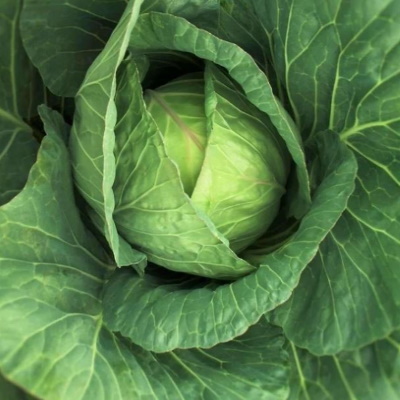 Danish Ballhead cabbage seeds produce heirloom cabbages that are mild and tender. This is a great, general-purpose cabbage that is good for sauerkraut, coleslaw, or general cooking. Big 8-25cm, light-green, well-protected heads stand happily in the garden well into the winter. Danish Ballhead was first introduced in 1887, and has remained a favourite ever since.
Danish Ballhead cabbage seeds produce heirloom cabbages that are mild and tender. This is a great, general-purpose cabbage that is good for sauerkraut, coleslaw, or general cooking. Big 8-25cm, light-green, well-protected heads stand happily in the garden well into the winter. Danish Ballhead was first introduced in 1887, and has remained a favourite ever since. -
Out of stock
 Early (60-65 days), high-yielding, cold-resistant heirloom variety. Small, compact plants with dense, round heads, weight 1.5-2 kg. Resistant to cracking.
Early (60-65 days), high-yielding, cold-resistant heirloom variety. Small, compact plants with dense, round heads, weight 1.5-2 kg. Resistant to cracking. -
Out of stock
 A great open-pollinated Savoy cabbage that was once a standard and is now very hard to find. Great for late summer and autumn rotations. Chieftain is more tender and sweet than many of the modern Savoy hybrids and withstands fall frosts. Produces vibrant green heads that average 2-3 kgs. A 1938 All American Selections award winner bred by Ferry-Morse. Sow indoors in flats with good potting soil April through July. Transplant into the garden about 4-6 weeks after sprouting. May also be direct sown once the soil is 10 C. Stunning crinkled or “savoyed” dark green leaves help to make this variety a visual treat in the garden. Savoy Chieftan is better tasting than all types of cabbage.
A great open-pollinated Savoy cabbage that was once a standard and is now very hard to find. Great for late summer and autumn rotations. Chieftain is more tender and sweet than many of the modern Savoy hybrids and withstands fall frosts. Produces vibrant green heads that average 2-3 kgs. A 1938 All American Selections award winner bred by Ferry-Morse. Sow indoors in flats with good potting soil April through July. Transplant into the garden about 4-6 weeks after sprouting. May also be direct sown once the soil is 10 C. Stunning crinkled or “savoyed” dark green leaves help to make this variety a visual treat in the garden. Savoy Chieftan is better tasting than all types of cabbage. -
Out of stock
 An excellent summer cauliflower. Solid curds and upright dark green leaves. Harvest in June from mid-March transplants. Cauliflower is a very rewarding vegetable to grow. They are a member of the brassica family. Produced earlier in the season with a June-early July harvest so it's a sensible early season choice for home gardeners. Curds are deep with tender florets and superior flavour. Transplant into rich, fertile soil and apply a balanced organic fertilizer at transplant time. Start in early March to transplant in 6-8 weeks or direct sow when soil is above 10 C.
An excellent summer cauliflower. Solid curds and upright dark green leaves. Harvest in June from mid-March transplants. Cauliflower is a very rewarding vegetable to grow. They are a member of the brassica family. Produced earlier in the season with a June-early July harvest so it's a sensible early season choice for home gardeners. Curds are deep with tender florets and superior flavour. Transplant into rich, fertile soil and apply a balanced organic fertilizer at transplant time. Start in early March to transplant in 6-8 weeks or direct sow when soil is above 10 C. -
Out of stock
 Snowball is a well-established cauliflower. Very early, dwarf compact plants produce a good size head; can be forced. Extremely reliable. Uniformly shaped, snow white heads that are thick and solid with tight curds. Good for both early and late season crops. Introduced in 1888, Early Snowball is somewhat self-blanching which means the large outer leaves tend to curl around the white head protecting it from the elements. Many growers will still tie the leaves up and around the head to protect it. Best grown during cooler portions of the growing season. Sow the snowball cauliflower seeds in compost in a seed tray or in small pots January-February under glass for July-August harvest. End of March-May outside in a seedbed, about 1 cm deep, or September-October in cold frames to overwinter. When seedlings are large enough to handle, plant them individually, keep them inside until they have 4-6 leaves. Plant outside, spacing 40- 35 cm apart, in well-drained soil, make sure you water the plants in sunny spells, protect from birds and slugs.
Snowball is a well-established cauliflower. Very early, dwarf compact plants produce a good size head; can be forced. Extremely reliable. Uniformly shaped, snow white heads that are thick and solid with tight curds. Good for both early and late season crops. Introduced in 1888, Early Snowball is somewhat self-blanching which means the large outer leaves tend to curl around the white head protecting it from the elements. Many growers will still tie the leaves up and around the head to protect it. Best grown during cooler portions of the growing season. Sow the snowball cauliflower seeds in compost in a seed tray or in small pots January-February under glass for July-August harvest. End of March-May outside in a seedbed, about 1 cm deep, or September-October in cold frames to overwinter. When seedlings are large enough to handle, plant them individually, keep them inside until they have 4-6 leaves. Plant outside, spacing 40- 35 cm apart, in well-drained soil, make sure you water the plants in sunny spells, protect from birds and slugs. -
Out of stock
 The name says it all this cauliflower is pristine white and the name says it all; Amazing. Medium-size plants with domed, solid curds and self-blanching, upright wrapper leaves when well fed. Tolerant to both heat and cold stress. Perfect for a new cauliflower grower, with large wrapper leaves that grow upright and shelter this cauliflower from the sun. The plants are medium-sized and will grow well in high altitudes and cooler climates as well as having the ability to withstand heat.
The name says it all this cauliflower is pristine white and the name says it all; Amazing. Medium-size plants with domed, solid curds and self-blanching, upright wrapper leaves when well fed. Tolerant to both heat and cold stress. Perfect for a new cauliflower grower, with large wrapper leaves that grow upright and shelter this cauliflower from the sun. The plants are medium-sized and will grow well in high altitudes and cooler climates as well as having the ability to withstand heat. -
Out of stock
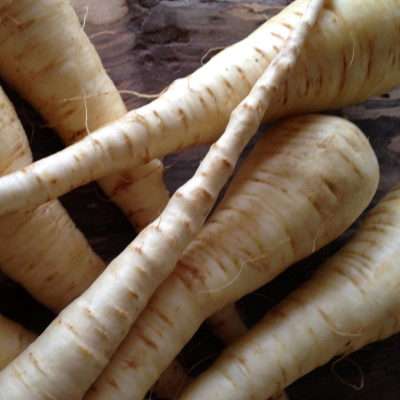 Our best parsnip seeds. Classic parsnip shape with a deep crown-set, wide, rounded shoulders, and roots that quickly taper. White Spear plants are vigorous and roots are uniform in shape. The roots are very white with smooth skins and a fine, mellow flavour that is very sweet as a roasted vegetable or simply chopped into soups and stews. It has excellent storage ability both in the ground and in cold storage. The ideal size for harvest is 30 cm. Many roots grow to more than 45 cm when soil is loose and left in the ground until frost. White Spear parsnip is the best choice for early spring planting and harvesting in early summer. Parsnip may be covered with mulch and left in the ground for winter harvest or until the following season for seed collection.
Our best parsnip seeds. Classic parsnip shape with a deep crown-set, wide, rounded shoulders, and roots that quickly taper. White Spear plants are vigorous and roots are uniform in shape. The roots are very white with smooth skins and a fine, mellow flavour that is very sweet as a roasted vegetable or simply chopped into soups and stews. It has excellent storage ability both in the ground and in cold storage. The ideal size for harvest is 30 cm. Many roots grow to more than 45 cm when soil is loose and left in the ground until frost. White Spear parsnip is the best choice for early spring planting and harvesting in early summer. Parsnip may be covered with mulch and left in the ground for winter harvest or until the following season for seed collection. -
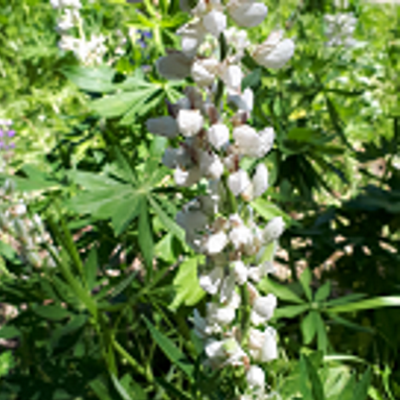
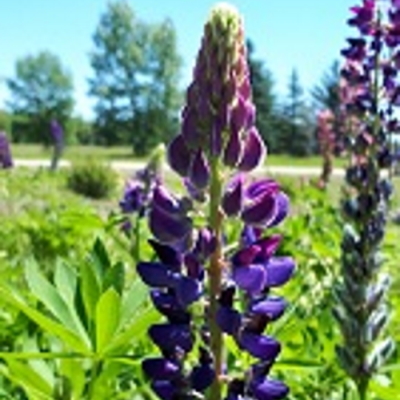 Stunning, brightly-colored spikes create a strong feature in the early summer garden. Its pea-like flowers grow in dense spires. Scatter through cottage or wildflower gardens or mass plant in the border. Purple, deep blue, red, pink, yellow, cream, and white. Lupins prefer a full sun position but will also grow well in semi-shade, they do not grow well in full shade. They grow well in a wide variety of soil conditions although chalky and/or waterlogged soil will be a problem if not improved before planting. If the ground is clay, lots of compost dug into the planting area will greatly increase their chances of surviving winters. Once your Lupins start to flower create new plants if you want more of a certain colour, gently separate the little offset at the base of a mature plant and replant it.
Stunning, brightly-colored spikes create a strong feature in the early summer garden. Its pea-like flowers grow in dense spires. Scatter through cottage or wildflower gardens or mass plant in the border. Purple, deep blue, red, pink, yellow, cream, and white. Lupins prefer a full sun position but will also grow well in semi-shade, they do not grow well in full shade. They grow well in a wide variety of soil conditions although chalky and/or waterlogged soil will be a problem if not improved before planting. If the ground is clay, lots of compost dug into the planting area will greatly increase their chances of surviving winters. Once your Lupins start to flower create new plants if you want more of a certain colour, gently separate the little offset at the base of a mature plant and replant it. -
Out of stock
 Growing on an upright bush, bright yellow, stringless pods of 10-15 cm are easy to spot among green foliage. Delicious buttery flavour. When planted in full sun they are prolific producers reaching a height of 37-50 cm tall and spread 37-50 cm.
Growing on an upright bush, bright yellow, stringless pods of 10-15 cm are easy to spot among green foliage. Delicious buttery flavour. When planted in full sun they are prolific producers reaching a height of 37-50 cm tall and spread 37-50 cm. -
Out of stock
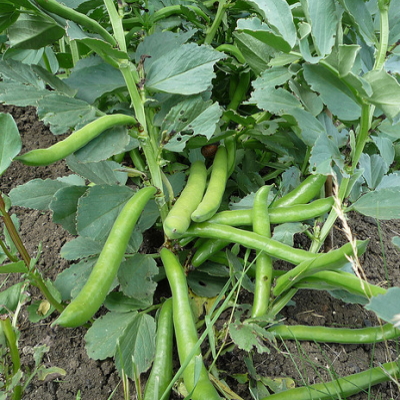 The best bean to try in 2021. Unlike most beans, fava beans prefer cool weather and are best planted in early spring as soon as the soil can be worked. Sow 2.5 cm deep, 10-12 cm apart, in rows 40-90 cm apart or use wide-bed style planting, giving each plant 25 sq.cm of space. Vroma produces large, 15-18 cm pods with 4–5 large seeds. Cook like a shell bean when the seeds are pale green or wait until pods are dry for shelled beans. Strong, heat-tolerant plants resist lodging. Light brown seeds. These lovely plants reach 1-1.5 M high and are self-supporting.
The best bean to try in 2021. Unlike most beans, fava beans prefer cool weather and are best planted in early spring as soon as the soil can be worked. Sow 2.5 cm deep, 10-12 cm apart, in rows 40-90 cm apart or use wide-bed style planting, giving each plant 25 sq.cm of space. Vroma produces large, 15-18 cm pods with 4–5 large seeds. Cook like a shell bean when the seeds are pale green or wait until pods are dry for shelled beans. Strong, heat-tolerant plants resist lodging. Light brown seeds. These lovely plants reach 1-1.5 M high and are self-supporting.